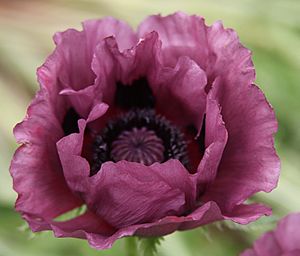Purple poppy facts for kids
The purple poppy is a special symbol used in the United Kingdom. It helps people remember animals that served during wars. This symbol was created in 2006. It was inspired by the traditional red remembrance poppy, which people wear on Remembrance Day to remember human soldiers.
Today, many animals helping the UK military are military working dogs. These dogs often work with the 1st Military Working Dog Regiment. In the past, the largest number of animals hurt or killed in wars were horses and ponies.
Why We Remember Animals in War
The purple poppy was first created in 2006 by a charity called Animal Aid. They wanted a way to remember animals that served in conflicts. The charity felt these animals were often forgotten victims of war. For example, about eight million horses and donkeys died during the First World War.
The purple poppy was designed to be worn alongside the red or white poppies. Animal Aid sold the purple poppy, with the money going to their work, until 2015. Then, they changed the symbol to an enamel purple paw badge. They felt the poppy was sometimes misunderstood. They wanted to show that animals are not "heroes" but innocent victims of war. After this, another charity, Murphy's Army, started selling the purple poppy symbol in 2016.
There is also a special "Purple Poppy Day" when people are encouraged to wear purple poppies. This day is different from Remembrance Day on 11 November. The date for Purple Poppy Day can change each year. In 2018, to mark 100 years since the end of the First World War, August 23rd was chosen. This date was picked because it was the day of the Battle of Mons, the first battle between British and German forces in the First World War.
How People Reacted to the Purple Poppy

The purple poppy was not officially supported by The Royal British Legion. This group sells the well-known red remembrance poppies. However, the Legion did say: "We see no problem with wearing the red poppy next to the purple or white poppy. Many people who support animal rights also support our work. We just ask that the different poppies are not sold together, as this might confuse people." Some towns have even included purple poppies next to red ones in their official Remembrance displays.


